Reviews
Most Complicated Modern Rolex: The Oyster Perpetual Sky-Dweller
Jay-Z’s got the 18K yellow gold and champagne-coloured dial model, “The Notorious One” Conor McGregor’s got the 18K Everose gold and chocolate-dial model, and even Tom Hardy, one of the finest actors of his generation, rocks the 18K white-gold and ivory-dial model. But beyond its obvious wrist swagger represented by its 42mm case size and 14mm case height, did you know that this watch is the equivalent of a mechanical supercomputer, combining two of horology’s most functional complications, the annual calendar and the GMT function?
Further, the way the watch has been set up provides unparalleled legibility and clarity when reading the month, date and time for both local and home time. Using an innovative and totally unique Ring Command system that interacts between the rotatable bezel, the winding crown and the movement, the Sky-Dweller is also the easiest and most intuitive-to-use annual calendar around.
Before delving into the specifics of how to use, set and read the Sky-Dweller as both an annual calendar and a multi-timezone watch, let’s first look at the history of these complications.

Jay-Z and his 18K yellow gold and champagne-coloured dial model
Why the Name Sky-Dweller?
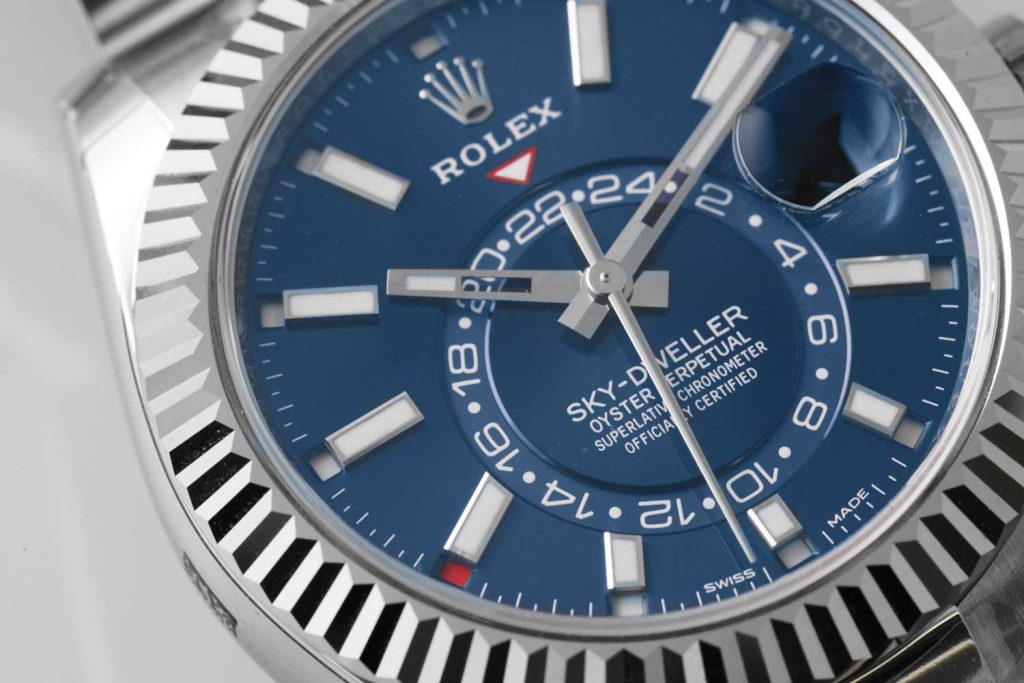
Oyster Perpetual Sky-Dweller (Reference 326934) in White Rolesor with a bright blue dial and an Oyster bracelet (©Revolution)
Rolex understood that for many of us who go through extended stretches waking up each day in a different city, it is our wristwatch that keeps us rooted and oriented, helping us navigate our way through the adventures that comprise modern life.
So what Rolex did with the Sky-Dweller was to create the ultimate companion watch for the modern traveller. A watch that, at one glance, gives you a perfect reading of time at home and also where you are right now. A watch that gives you perfect and easy reading of both date and month. A watch that is so intelligent that it knows which months have 30 days and which months have 31 and adjusts the date for you accordingly.
And finally, it is a watch that, despite all this incredible ability, is fun, intuitive and easy to use. Welcome to the world of the Rolex Oyster Perpetual Sky-Dweller.
What is an Annual Calendar?
What is an annual calendar, and why is it, to me, the most pragmatic and useful complication around? What you need to know is that the Sky-Dweller is genius-level smart despite its fun, easy-going affability.
Like a MENSA-qualified supermodel with an IQ of 162 that reads Martin Heidegger in her free time and solves seemingly impossible mathematical problems while performing Ashtanga inversions yet is laidback enough to watch the game and have a beer with you and your boys, the Sky-Dweller is the total package.
It is an annual calendar watch that automatically calculates which months in the year have 30 days and which months have 31 days. Meaning that as long as you keep it wound, which is relatively easy considering how quickly its ultra-efficient, bidirectional rotor charges its barrel, you need only correct it once each year, on March 1st.
The annual calendar is derived from the perpetual calendar, which is a watch capable of automatically compensating for the shifting 30/31-day rhythm of the months as well as accounting for the 28 days in February, and even knowing when the extra day every leap year is. The first watch with a perpetual calendar mechanism was created in 1762 by British watchmaker Thomas Mudge and became a popular feature of pocket watches for discerning gentlemen the following century.
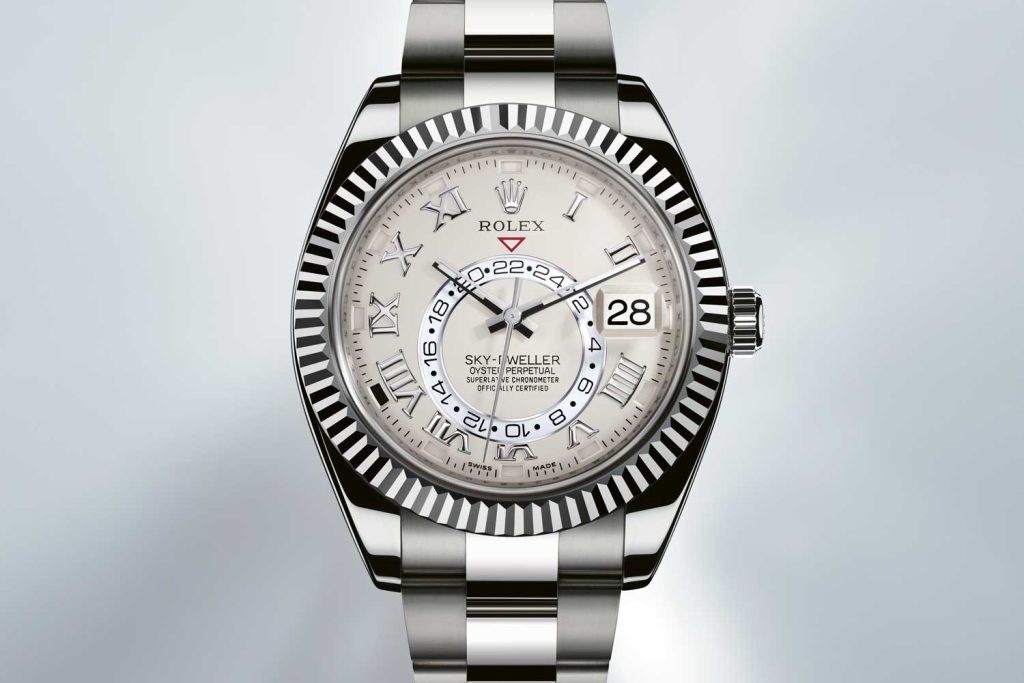
The first Sky-Dweller model launched in 2012.
In 2012, Rolex unveiled its first-ever annual calendar with the Sky-Dweller. As Rolex has always pursued the creation of the most reliable, accurate and robust watch on the planet, it made sense that the company would decide to focus on the more pragmatic annual calendar rather than the perpetual calendar. Never one to disappoint, Rolex’s annual calendar was a level above anything that had come before in terms of ease of use and robustness. When Rolex introduced the calibre 9001 — one of the most complex calibres ever created by Rolex watchmakers — for the Sky-Dweller, it did so using an all-new display that made reading the calendar information incredibly legible. Amazingly, this watch received 14 patents despite adding only four more gear wheels to its existing calibre in order to create the annual calendar and GMT functions.
Dual Time Zone and 24-Hour Display
No brand has more legitimacy in the category of the GMT watch than Rolex. In 1955, Rolex created the very first watch with this complication known as the GMT-Master, which was originally developed as a navigation instrument for professionals criss-crossing the globe. This amazing timepiece was developed soon after Rolex became the official watch of Pan American World Airways, better known worldwide as Pan Am, the most prominent American intercontinental airline at the time.The key features for this timepiece was an additional GMT hand read off a stunning Bakelite bezel that displayed time in a 24-hour format. The bezel was subdivided into red and blue sections to differentiate between day and night hours, and most importantly, could be rotated to show time in a different zone. Since then, Rolex has been synonymous with the multiple-timezone watch; most famously, the GMT-Master II, heir to the original model that was unveiled in 1982, which added the ability to decouple and advance or retreat the hour hand for a new local time reading without affecting the running of the seconds or the minutes. This feature would make an appearance in the incredible Sky-Dweller.
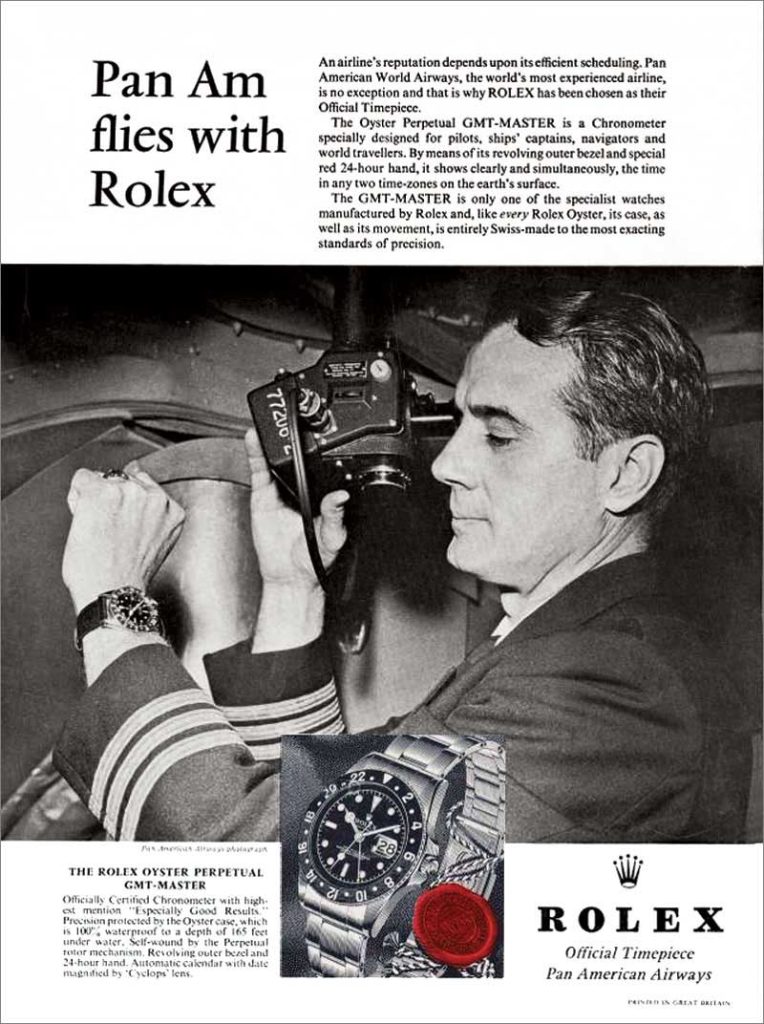
Vintage advertisement showing a Pan Am pilot checking out his Rolex GMT-Master
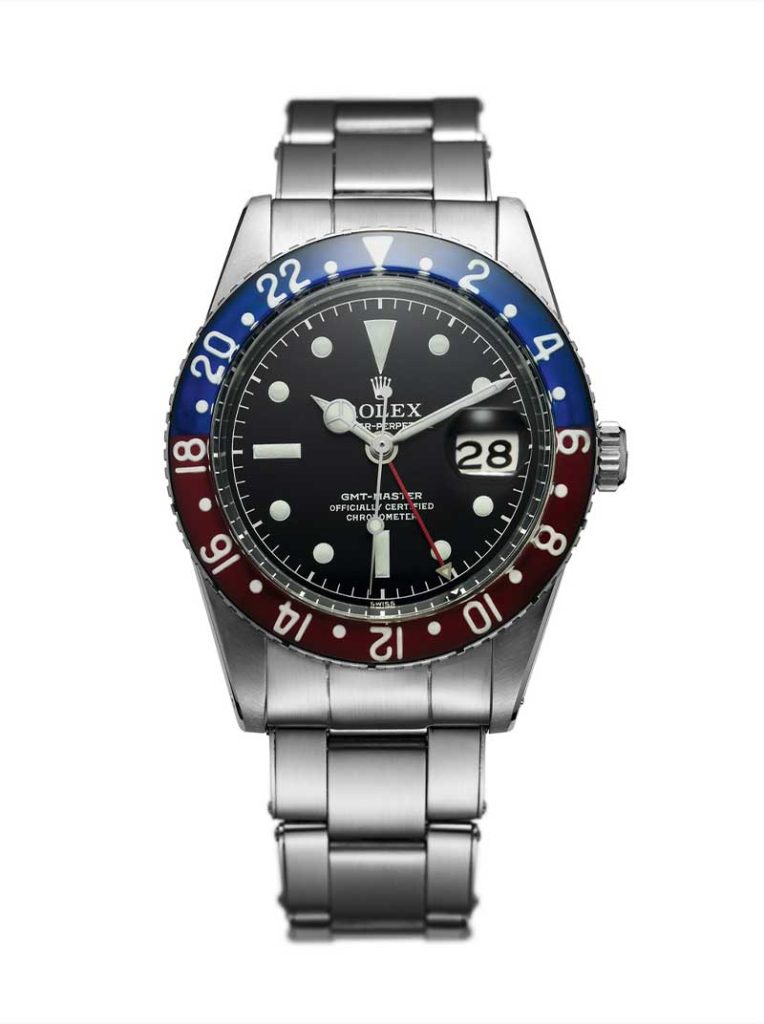
Rolex launched the GMT-Master in 1955, the reference 6542; the watch had a rotating bezel with a luminous bakelite insert and a second hour hand to help the watch track an alternate timezone
The Sky-Dweller Dial
The dial of the Sky-Dweller is laid out in the following way. Hours and minutes are told off the hands at the centre. The reference time or home-time display sits inside of the dial in an off-centre 24-hour disc. A fixed inverted red triangle beneath the Rolex logo points to the home time, which is always located at the top position within this display.
Note that when the hands of the 24-hour display are running together, this display becomes a highly pragmatic a.m./p.m. indicator. However, the hands can also be decoupled and quickset to a new local time when you travel to a new timezone. Amazingly, thanks to the Rolex jumping hour hand, the hour hand is adjusted independently in one-hour increments, either forwards and backwards, leaving the minute and seconds hands, as well as the reference time, unchanged.
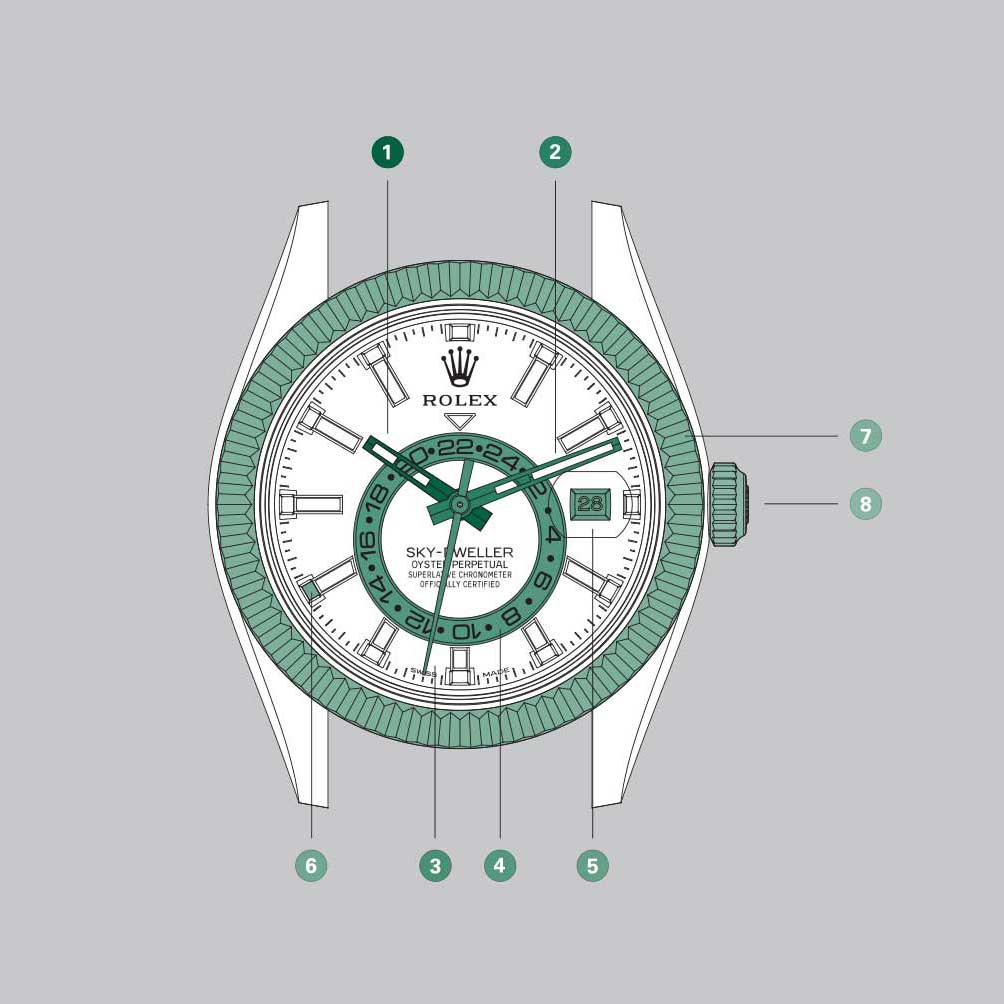
Labelled diagram of the Oyster Perpetual Sky-Dweller case and dial
1. Hour hand
2. Minute hand
3. Seconds hand
4. Reference time display on 24-hour disc
5. Date window
6. Month display in one of 12 windows (January at 1 o’clock, February at 2 o’clock, etc.)
7. Bidirectional rotatable bezel
8. Twinlock winding crown with double waterproofness system
[/td_block_text_with_title][vc_row_inner css=”.vc_custom_1608097343345{background-color: #c8c7cc !important;}”][vc_empty_space][vc_empty_space]
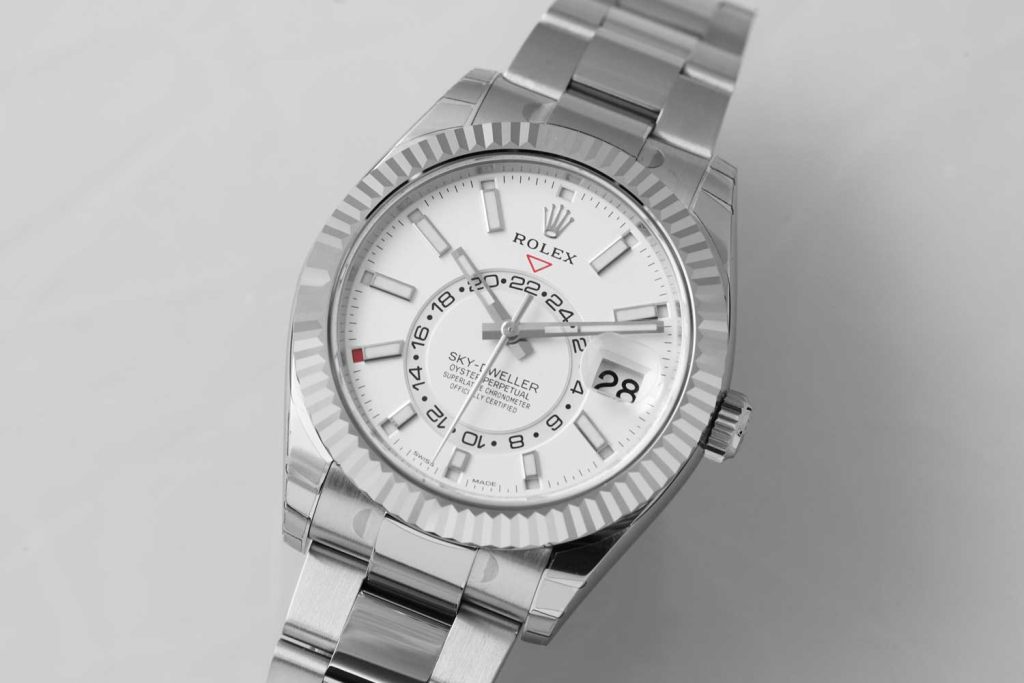
The Oyster Perpetual Sky-Dweller (Reference 326934) in White Rolesor with an intense white dial and an Oyster bracelet (©Revolution)
Now the great irony in life is, when you reach a point in your life when you can afford a complicated watch, it’s usually at an age where your eyesight is no longer optimal. Personally, I struggle to read the calendar information on my watches. Well, all except the Rolex Sky-Dweller. Why? It’s because of the combination of large date magnified by Rolex’s signature Cyclops lens and a very unique and cool way of displaying the months.
Where exactly is the month indicator on the Sky-Dweller? Good question. Because in all other annual calendars, the month is always shown using either an aperture with a disc or using a small hand and a subdial.
But on the Rolex Sky-Dweller, you’ll notice that the months of the year are indicated in 12 discreet apertures around the circumference of the dial. You don’t see these immediately because they are galvanically treated the same colour as the dial. There are a total of 12 hour indexes which also serve as the 12 month indicators, when the aperture corresponding to any given month is filled with a contrasting red indication (in earlier watches, this could be white for the chocolate-dial watches and black for the watches with champagne or ivory-coloured dials).
When it is March, the aperture at the three o’clock index will turn red and when it is November, the aperture next to the 11 o’clock index will be red. You get it. While in previous dial executions with Roman indexes, the apertures were slightly wider and rectangular in shape, with the shift to baton-styled markers, the windows for the month indicator of the Sky-Dweller are now all uniformly square-shaped and the contrast is red in colour regardless of the dial execution or case material.
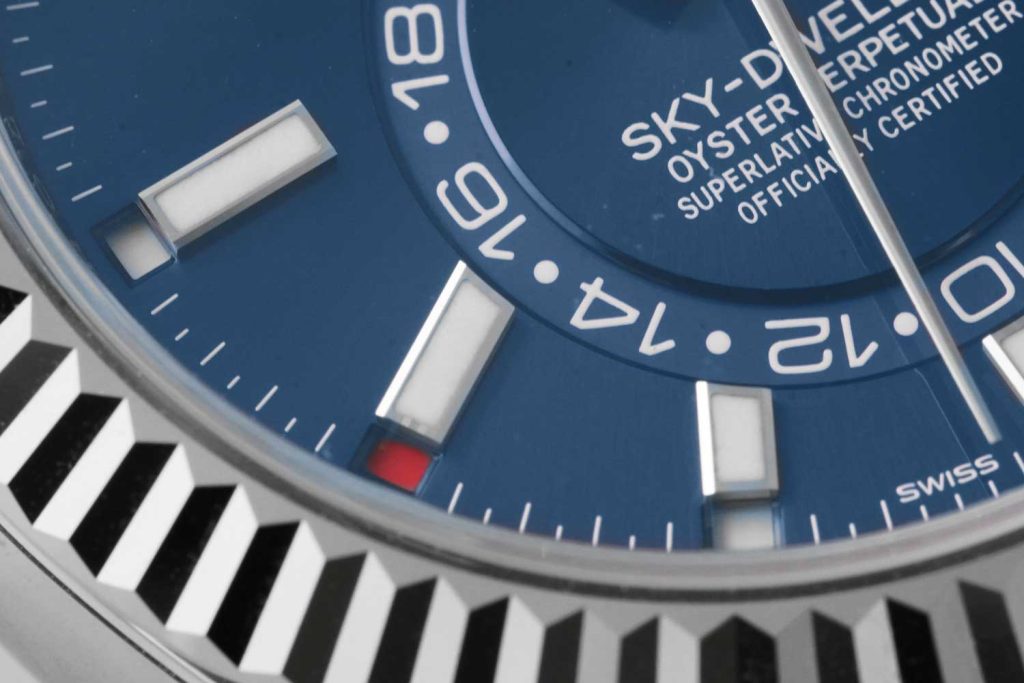
The aperture paired with the 8 o'clock hour marker here is in red showing that it is now the month of August, which of month 8 of 12 in the year (©Revolution)
How to Set and Use the Rolex Sky-Dweller
While most annual calendars necessitate you using a series of pushers around the case, for Rolex, any marring of the signature Oyster Perpetual case would not be acceptable as it would mean an added risk and compromises to water resistance. Instead, Rolex devised a way to wind, set the date and month both backwards and forwards, set the time and set the main hands to a second timezone, all while using just the watch’s winding crown and rotatable bezel. It is important to note that the Sky-Dweller presents the specificity of having a synchronised instantaneous annual calendar that is fully operated by the crown and the bezel, and that can be adjusted both forwards and backwards.
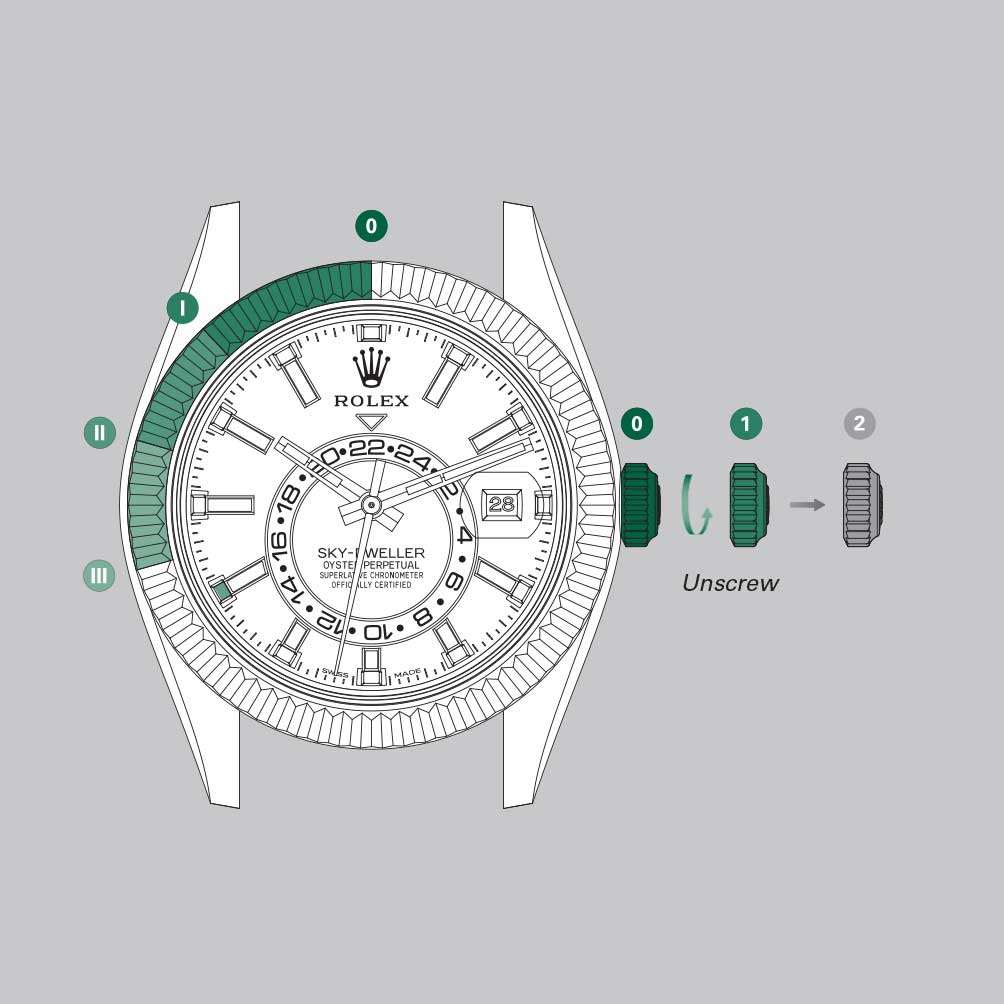
Labelled diagram of the Oyster Perpetual Sky-Dweller case and dial showing the different positions of the rotating bezel and crown
The Crown Positions 0, 1 and 2
The crown of the Sky-Dweller is Rolex’s famous Twinlock crown, which has two sealed zones, one inside the tube, the other inside the crown to provide water resistance. In order to activate the crown, you need to first fully unscrew it to its first position. When it is screwed down, the Sky-Dweller is waterproof to depths of 300 metres. In this fully screwed position, the crown is considered to be in Position 0.
At Position 1, you can turn the crown to wind the barrel — useful primarily if the watch has been sitting for a long time and has stopped. However, once you start wearing the Sky-Dweller, its ultra-efficient automatic-winding rotor will quickly charge the movement. Note that the watch has approximately 72 hours of power reserve when fully wound.
To set the calendar information and time, you need to pull the crown to Position 2 (more on this later).
The Rotatable Bezel Positions I, II and III
The genius of Rolex is its capacity to take a complex mechanism like a watch with a GMT indicator as well as a mighty annual calendar, and make them so relatable and easy to use that they are genuinely fun to play around with. One huge factor to this is that when Rolex engineers any kind of watch, they go out of their way to ensure that the watches are incredibly easy to use. Which is not the truth for the vast majority of other watches. Want an example? Did you know that in most other watches with date, if you try to set the date close to midnight when it is changing over, the movements can get jammed? In contrast, you can set the date on a Rolex Oyster Perpetual Datejust at any hour.
Similarly, the Rolex Sky-Dweller is simple, easy and fun to use. Here is how you do it:
It’s actually really fun to play around with this. And it’s impossible to damage the watch by turning it too far forwards or backwards.
The first thing you want to do when setting your Sky- Dweller is turn the bezel all the way counter-clockwise. To be precise, that’s three clicks to the left, which will put you in Position III. Now with the crown pulled all the way out (Position 2), you set the time.
OK, this is the important part: To set the hours, you do so with the 24-hour reference time display in the centre of the dial. Note that the inverted red triangle will point out the correct hour and that you will need to distinguish between day and night hours. 10 a.m. is 10:00 while 10 p.m. is 22:00.
To set the minute, you use the main minute hand of the watch. Also notice that in this mode, the seconds hand of the watch is stopped, allowing you to set the time precisely.[/td_block_text_with_title]
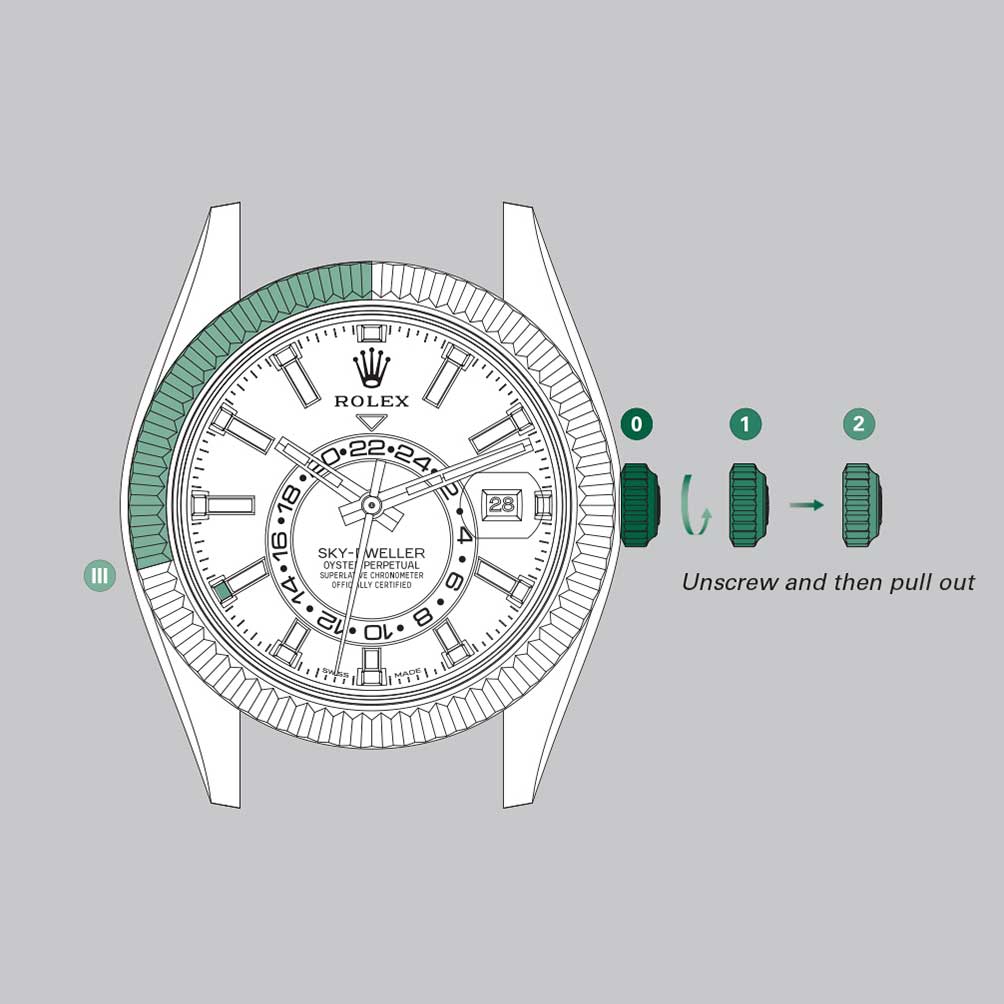
Bezel and crown positioning for setting the reference/home time
Here, you can move the hour hand either backwards or forwards without disturbing the running of the watch. In this mode, the seconds and minute hands continue to run. This is so that later, if you want to set a new local time when you are travelling, you can do so without affecting the watch’s underlying timekeeping precision.
OK, what you want to do is move the hour hand so that it is in sync with the reference time on the 24-hour disc. You need to distinguish between a.m. and p.m. which you can do by noticing if the date changes when you cross 12 o’clock. If it does, you are in a.m. hours and if it doesn’t, you are in p.m. hours. Pretty simple, right?[/td_block_text_with_title]
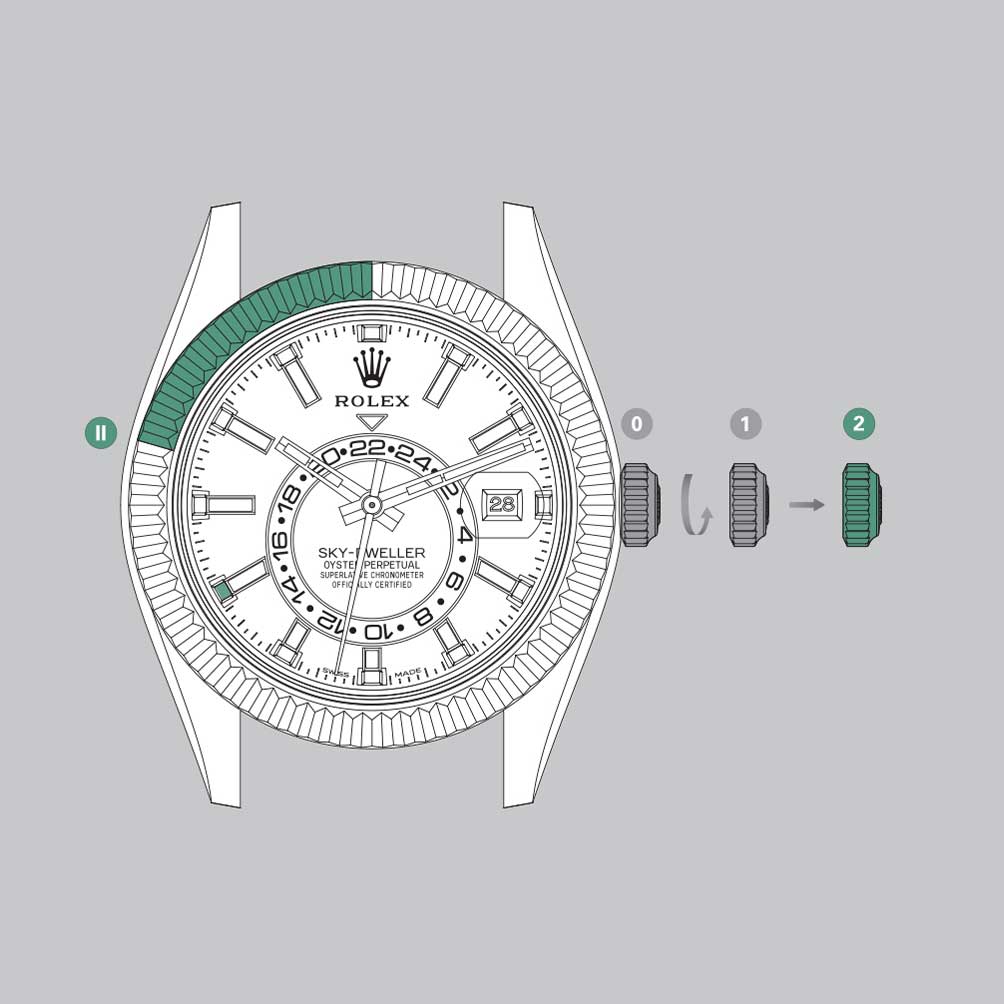
Bezel and crown positioning for setting the local time
So turn the bezel one more time to the right to find Position I. Now, by turning the crown, you advance the date forward or backward.
Note that the month which is represented by the aperture next to any of the hour indexes turning red follows the date forward or backward. Just try setting the date from November 30th to December 1st, and you’ll see what I mean. Now set the date backwards from 1 directly to 30 and you’ll see the red indicator jump from the aperture at 12 o’clock to the aperture at 11 o’clock.
* The date shown here is 28 August[/td_block_text_with_title]
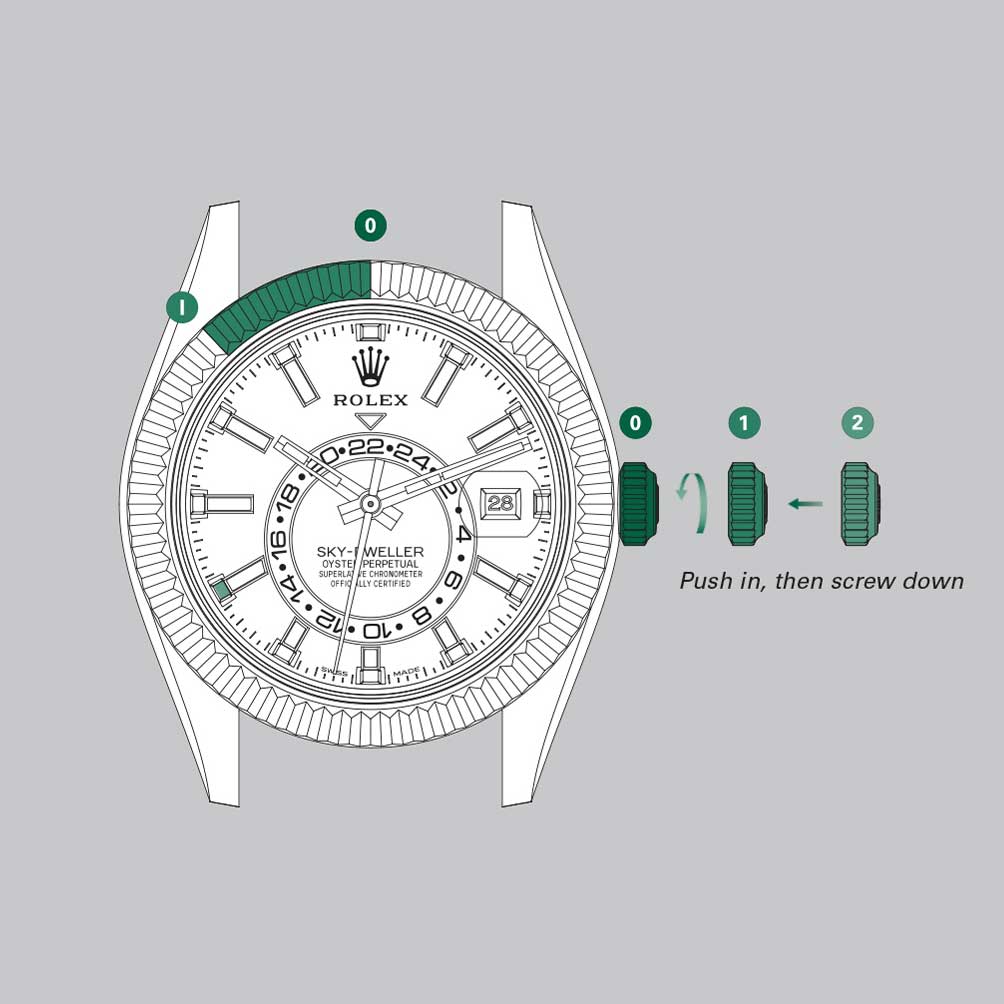
Bezel and crown positioning for setting the date and month
Using the GMT Function
OK, so let’s look now at how the Sky-Dweller is such an awesome travel watch. For example, you are travelling from Paris to London. Before you disembark the plane, you can adjust the time backwards or earlier by an hour. Say, you are travelling from Singapore to London, then you would adjust the time backwards by seven hours. In either case, you just need to put the bezel in Position II, unscrew and pull out the crown and give it the right number of turns.
Deciding What Position to Leave the Bezel In
Once all the timekeeping and calendar information is correctly set, you can screw the crown back in. Regarding the position of the bezel, you can restore it to what I consider the default neutral position or Position 0 to the far right (clockwise three clicks).
But the fun thing with the Sky-Dweller is the more you play around with it, the better you get at using it. The beauty of the Sky-Dweller is that even if you are sitting on your couch and want to do a virtual trip around the world, or just like looking at the apertures for the months changing over, you can feel free to change the hands and the indicators as much as you like.
The more you use it, the more you will master the Sky-Dweller and learn to put the bezel in a position that best suits your needs. For example, if you are getting ready to travel, you can already set it two clicks to the left to Position II. This allows you to immediately access the GMT function, and as soon as you get off the plane, you are ready to rock.
Finally, if you just need to advance or reverse the date, for example, on March 1st, you can turn the bezel one click to the left from the neutral position to Position I and you can immediately advance the date without disturbing the watch’s timekeeping precision.
Built to Last
Let’s place this within the context that, at Rolex, the objective is always to create the easiest to use and most intuitive watches. It is also important that functions can be activated while ensuring that the watch is completely safe from being damaged.
The more complicated a watch becomes, the more fragile it is in general. However, when Rolex decided to create its first annual calendar watch, it knew it had to also create an intuitive way of setting all information in a watch that would be dependable. Part of this was the use of gear wheels for all the calendar information, which means they can be set backwards and forwards with ease. However, while testing various ways to array the setting functions, Rolex ended up inventing the unique Ring Command system.
More About the Ring Command System

A view of the planetary gear system of the rotatable fluted bezel, controlled by the crown, which in different positions, offer up a number of different complications on the Oyster Perpetual Sky-Dweller
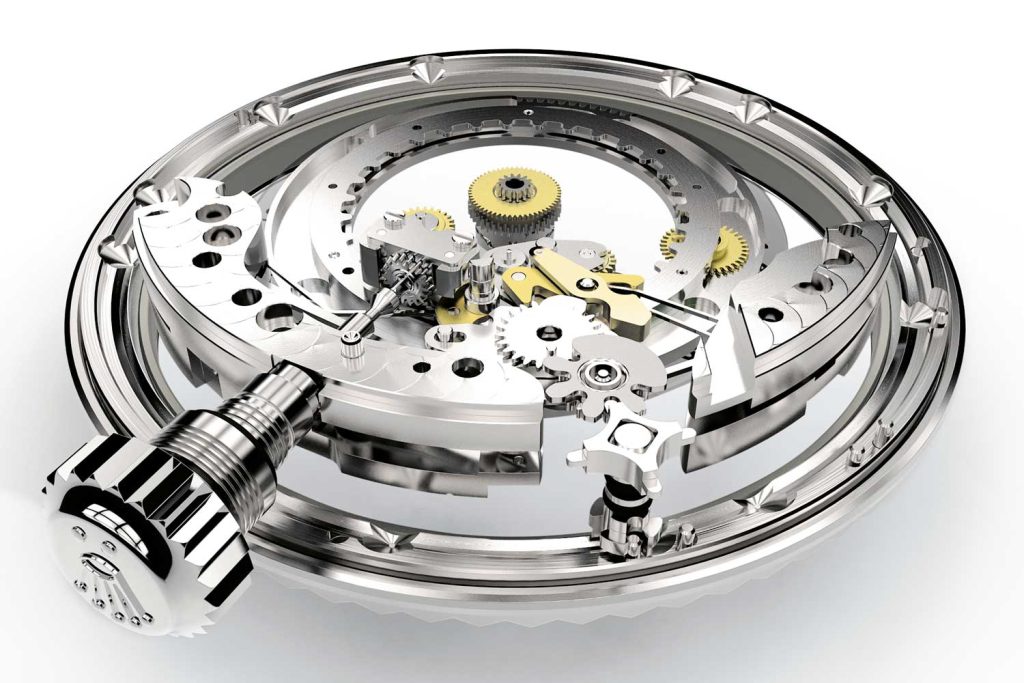
A view of the planetary gear system from the business side of the rotatable fluted bezel, controlled by the crown, which in different positions, offer up a number of different complications on the Oyster Perpetual Sky-Dweller
Rolex clearly saw the pragmatic advantages of the rotating bezel, which can turn a full 360 degrees and thus, could theoretically offer setting positions for a vast number of complications. While the Ring Command system seems like a simple and elegant solution, it is actually belied by a vast amount of technical innovation and comprises a 50-part module involving both a planetary gear system and a column wheel, which is activated when the crown is pulled out. I find it somehow fitting that, in the most accessibly priced Sky-Dweller model with an Oystersteel case, the bezel is still made in gold, as it underscores how epically valuable this element is from a functional perspective.
The Case
The case of the Sky-Dweller is one of the most complex case ever created by Rolex, but it is still descended in direct lineage from the original Oyster case patented by Rolex back in 1926.
This design incorporates the following: 1) screw-down crown, 2) screw-down caseback — with its characteristic fluting that fits into a special tool exclusive to Rolex watchmakers, so only they can access the movement, and 3) screw-down bezel — originally, the unique fluting on the bezel was used for a tool to grip and turn it to lock it in place.
The modern Sky-Dweller features a 42mm case diameter, which has also been selected by Rolex to optimise visibility.
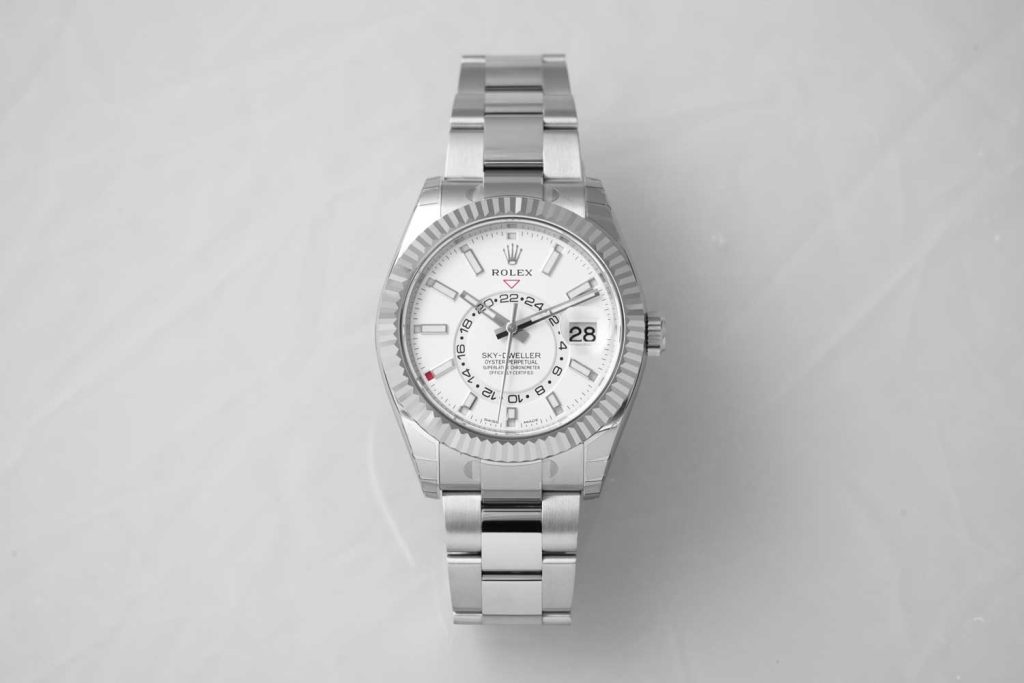
The Oyster Perpetual Sky-Dweller (Reference 326934) in White Rolesor with an intense white dial and an Oyster bracelet; the case of the watch features the same know-how that Rolex developed in 1926 with the original Oyster case (©Revolution)
The Rolesor Models
It is important to know that all alloys for Rolex watch cases are cast in-house by Rolex. There are two materials that are used to create the watch cases for the Sky-Dweller model. These are gold and Oystersteel.
In 2017, Rolex unveiled a Sky-Dweller in Rolesor, Rolex’s signature marriage of Oystersteel and 18K gold.. There were actually two variations on the Rolesor theme for the Sky-Dweller. The first was an Oystersteel case with an 18K yellow gold bezel, crown, and centre links in the bracelet. This model featured champagne-colour, white and black dials.
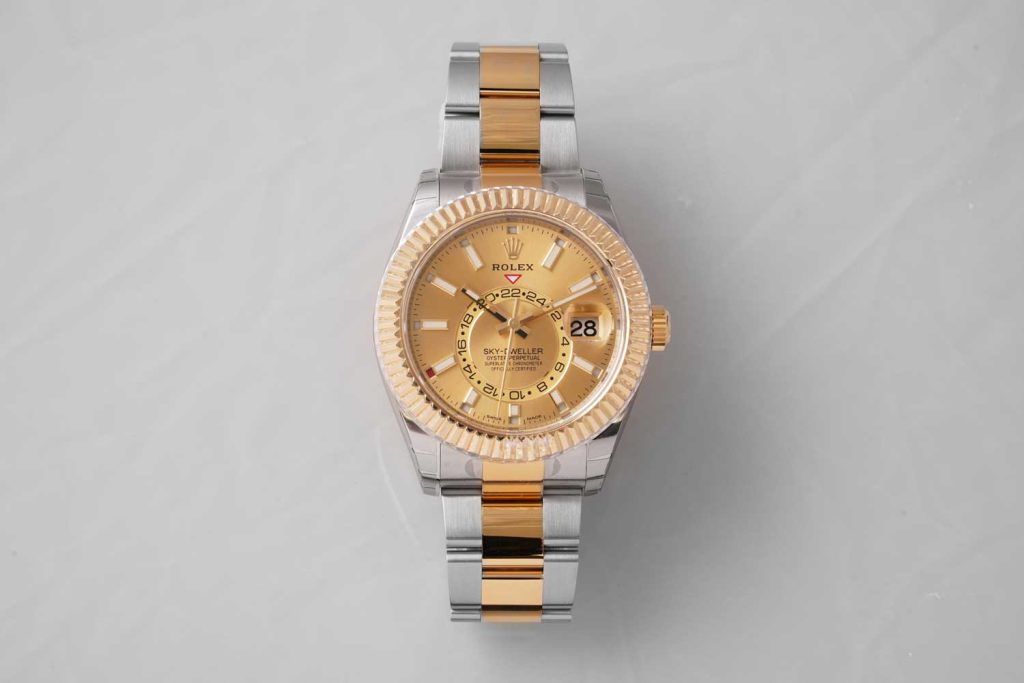
The Oyster Perpetual Sky-Dweller (Reference 326933) in Yellow Rolesor with a champagne-colour dial and an Oyster bracelet (©Revolution)
We should pause to discuss the material it is made from, specifically, Oystersteel. While all other brands use the industry standard of 316L stainless steel, it is only Rolex that uses 904L stainless steel. What is 904L steel, and how is it distinguished from 316L steel? Well, it features a much higher corrosion resistance as well as a higher surface hardness than 316L. Since inception, the tradition at Rolex has always been to research the way their watches wear over time. And they found that with hard use, their watches, like others made from traditional stainless steel, would experience corrosion in the threads of the caseback and the caseback itself because of the build-up of sweat and moisture. 904L steel was selected as a new material because of its resistance to acids. Specially developed by Rolex, Oystersteel is not only extremely resistant but also offers exceptional sheen. Rolex watches manufactured with this special steel retain their beauty even when exposed to the most extreme conditions.
Developed by Rolex and manufactured exclusively for the brand, each Oystersteel casting undergoes in-house quality control in Rolex’s Central Laboratory and then scanned with an electron microscope for any imperfections, including any structural or surface defect. After inspection, the steel is re-melted in a vacuum to purify it and remove inclusions that would compromise its corrosion resistance. As you can see, Rolex’s focus is on creating watches that would endure forever. Why do other brands not use 904L? Because it is much harder to machine and requires special tools to do so. Since 2003, all Rolex steel watches have been using the 904L-based Oystersteel.
The Everose Models
As mentioned, all gold watches at Rolex are made from alloys that are cast in-house at Rolex’s Plan-les-Ouates facility. I’ve had the opportunity to visit and I can say that it is sincerely awesome to witness the foundry melting gold down before it is mixed to create the signature alloys. Gold watches are not pure 24K gold. This would render the cases too soft to be pragmatic. At Rolex, gold watches are 18K gold, which means a minimum of 75 percent pure gold. In 2005, Rolex took the step to create their very own patented pink-gold alloy called Everose.
Why? Because they discovered that over time, traditional pink gold starts to lose its colour and ends up looking quite similar to yellow gold. As with the creation of Cerachrom bezel inserts, it is clear that Rolex like their watches to endure forever. And so Rolex set about creating an alloy of pink gold that would never fade in colour, intensity or hue over time. But if you thought that Rolex would reveal the exact recipe to you, you don’t know Rolex.
The first watch to receive an Everose case was the Cosmograph Daytona in 2005. One of the most beautiful executions of the Sky-Dweller is with an Everose case. As of this year, the watch comes on both a matching Everose bracelet model with dials in bronze, white and grey, and on the ultra-cool rubber Oysterflex bracelet, which brings an added sporty dimension to the Sky-Dweller. The combination of an Everose case with an Oysterflex bracelet is available with all three coloured dials as well.
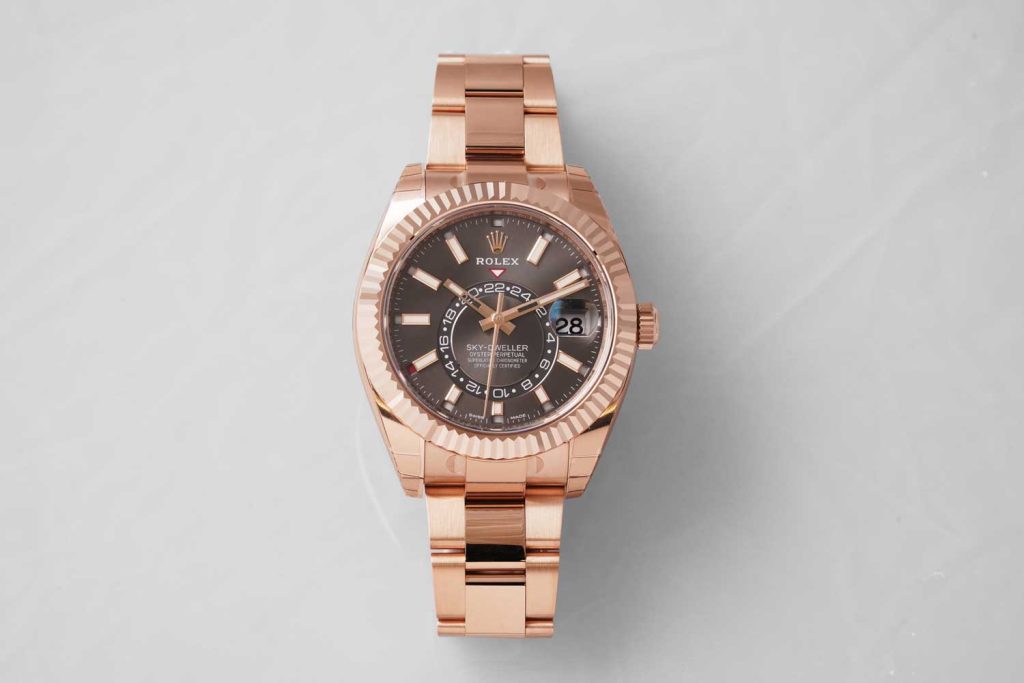
The Oyster Perpetual Sky-Dweller (Reference 326935) in 18 ct Everose gold with a chocolate dial and an Oyster bracelet (©Revolution)
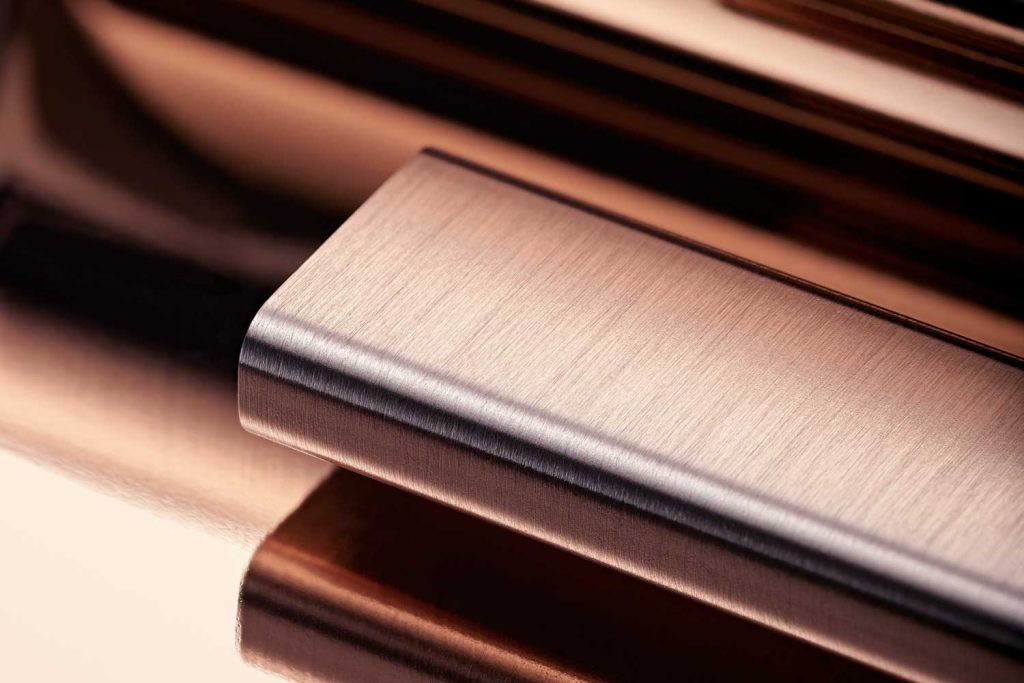
Everose gold, like all gold alloys at Rolex, are cast in-house at its Plan-les-Ouates facility.

Everose gold, like all gold alloys at Rolex, are cast in-house at its Plan-les-Ouates facility.
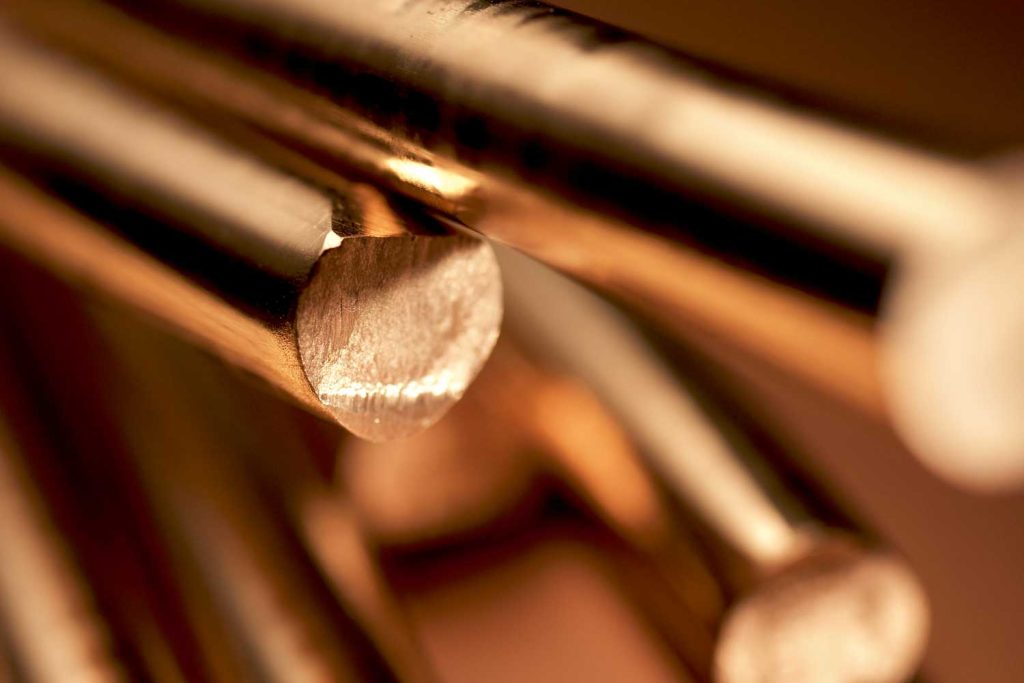
Everose gold, like all gold alloys at Rolex, are cast in-house at its Plan-les-Ouates facility.
Bracelet
Since its introduction, the Sky-Dweller has been fitted with an Oyster bracelet. This bracelet features the Easylink rapid extension system that allows you to add 5mm in size to the bracelet for additional comfort. This may not seem like much but a person’s wrist swells throughout the day depending on their activity, the time of day and even temperature and humidity. The Easylink system can provide a significant relief to a watch that may have felt like the perfect fit in the beginning of a cold morning. The Oyster bracelet also has a new concealed attachment system beneath the bezel for seamless continuity from the case and bracelet.
The Oysterflex Bracelet
Whilst aesthetically simple and understated, the reality of the Oysterflex bracelet is far more complex. The idea was this: rubber straps, while practical for sports, tend to lack any real structure, causing watches fitted with them to tend to lack any real structure, causing watches fitted with them to tend to move around the wrist. Rolex’s Oysterflex bracelet addresses this issue perfectly. First, the bracelet starts as thin, flexible blades of titanium-nickel alloy. Next, they are over-moulded with a special black elastomer, which gives them the appearance of rubber straps when they are actually, in truth, bracelets with proper structure. For added comfort and air circulation, Rolex has even added longitudinal cushions into the strap that stabilises the watch on the wrist, and has fitted the strap with an Oysterlock safety clasp that prevents accidental opening. The result is the perfect rubber bracelet. All Oysterflex bracelets also feature Rolex’s Glidelock technology, which allows you to fine-adjust the bracelet size by increments of 2.5mm for a total of 15mm.
As of this year, the Sky-Dweller in 18K yellow and Everose gold now comes with an option of the Oysterflex bracelet. That is, the 18K yellow gold watches with dials in white, champagne-colour and bright black, and 18K Everose gold watches with chocolate, white and dark rhodium dials.
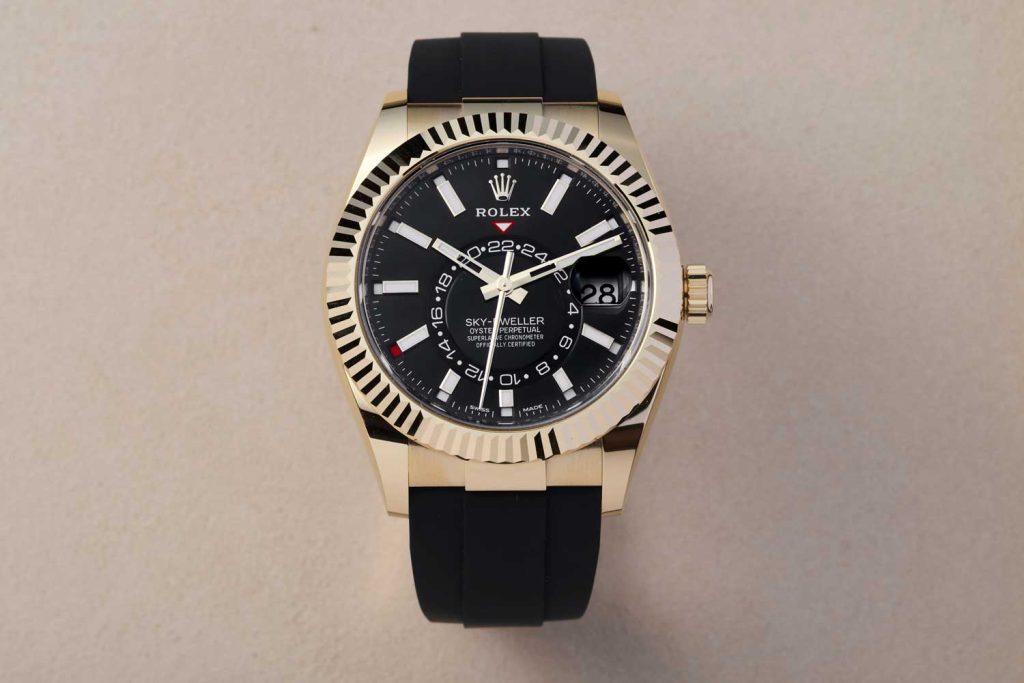
The Oyster Perpetual Sky-Dweller (Reference 326238) in 18 ct yellow gold with a bright black dial and an Oysterflex bracelet (©Revolution)
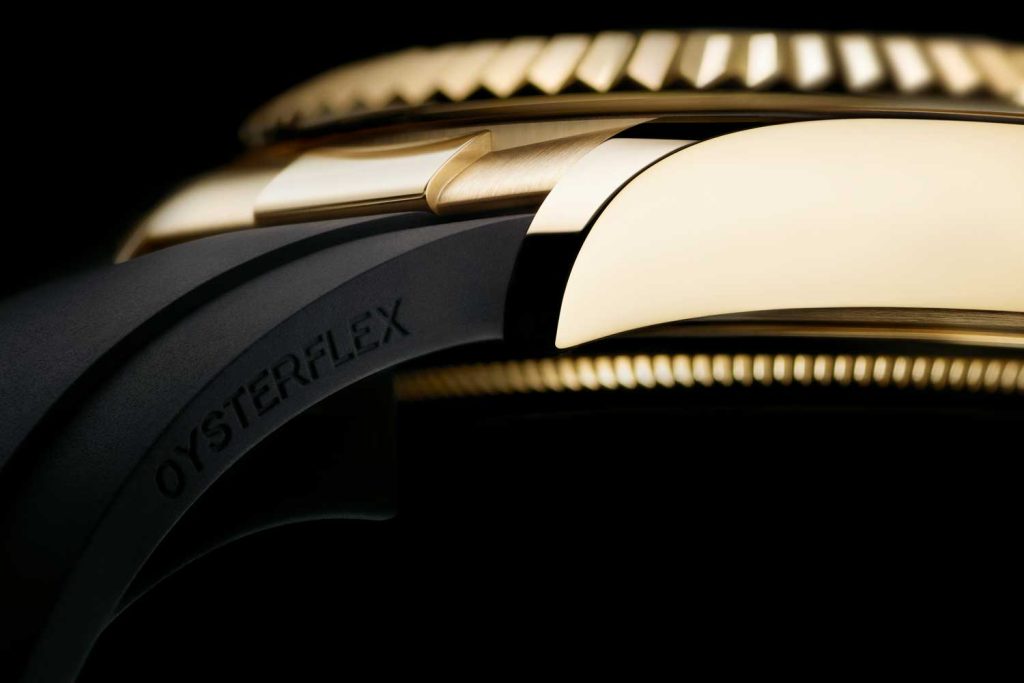
The Oysterflex bracelet is simple in aesthetics but complex in its making
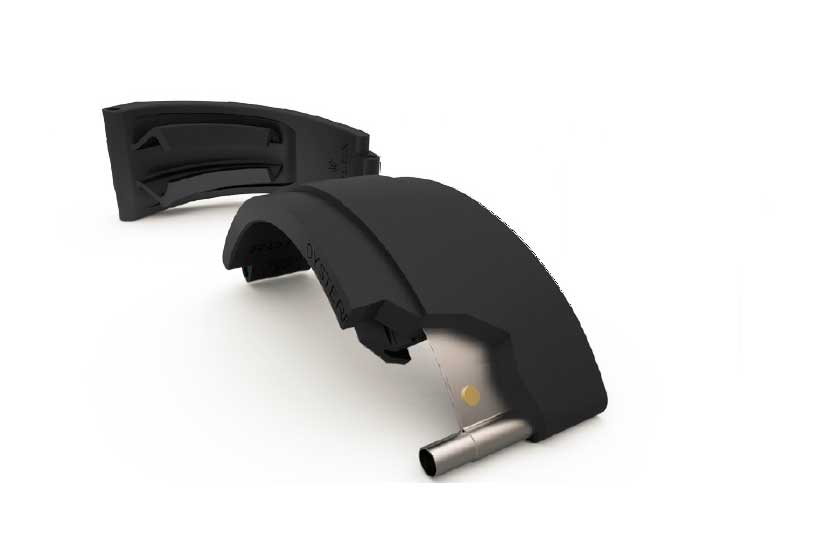
Diagram showing the thin, flexible blades of titanium-nickel alloy, which are over-moulded with a special black elastomer to form the Oysterflex bracelet
Calibre 9001
When the Sky-Dweller was unveiled in 2012, watch aficionados were desperate to understand how the movement functioned. We were told that the entire annual calendar mechanism comprised of just four more wheels which, of course, was typical Rolex understatement because, in truth, the calibre 9001 powering the Sky-Dweller was the single most complex movement they had ever created, comprising 380 parts and holding 14 patents.
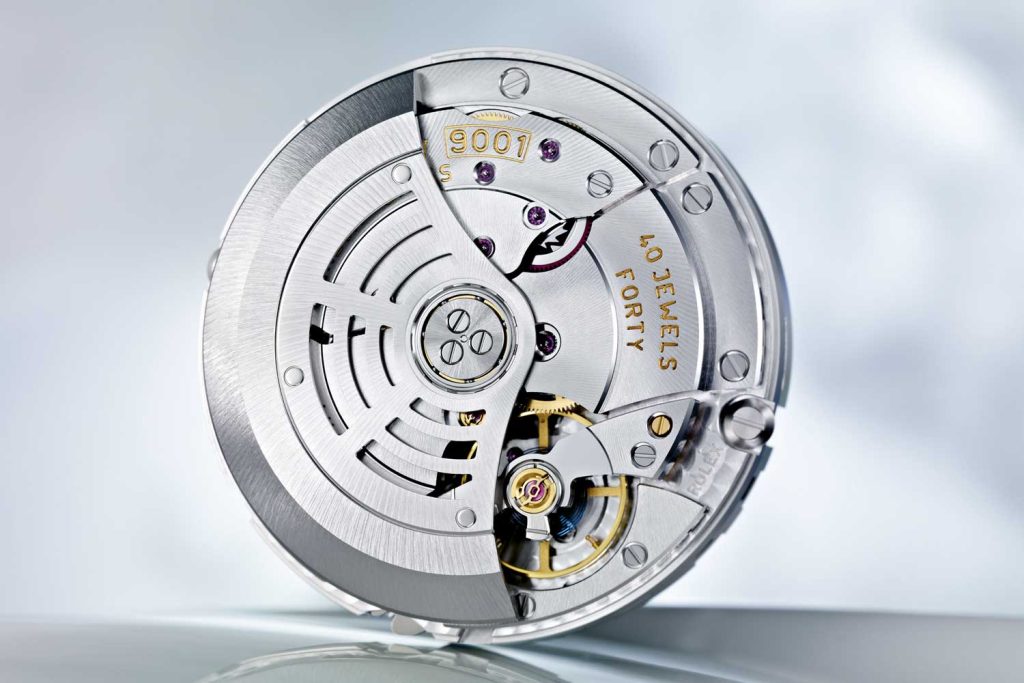
The calibre 9001.
– a main satellite wheel for the date,
– a planetary wheel for the months
– and a second satellite wheel for the months that have 30 days.
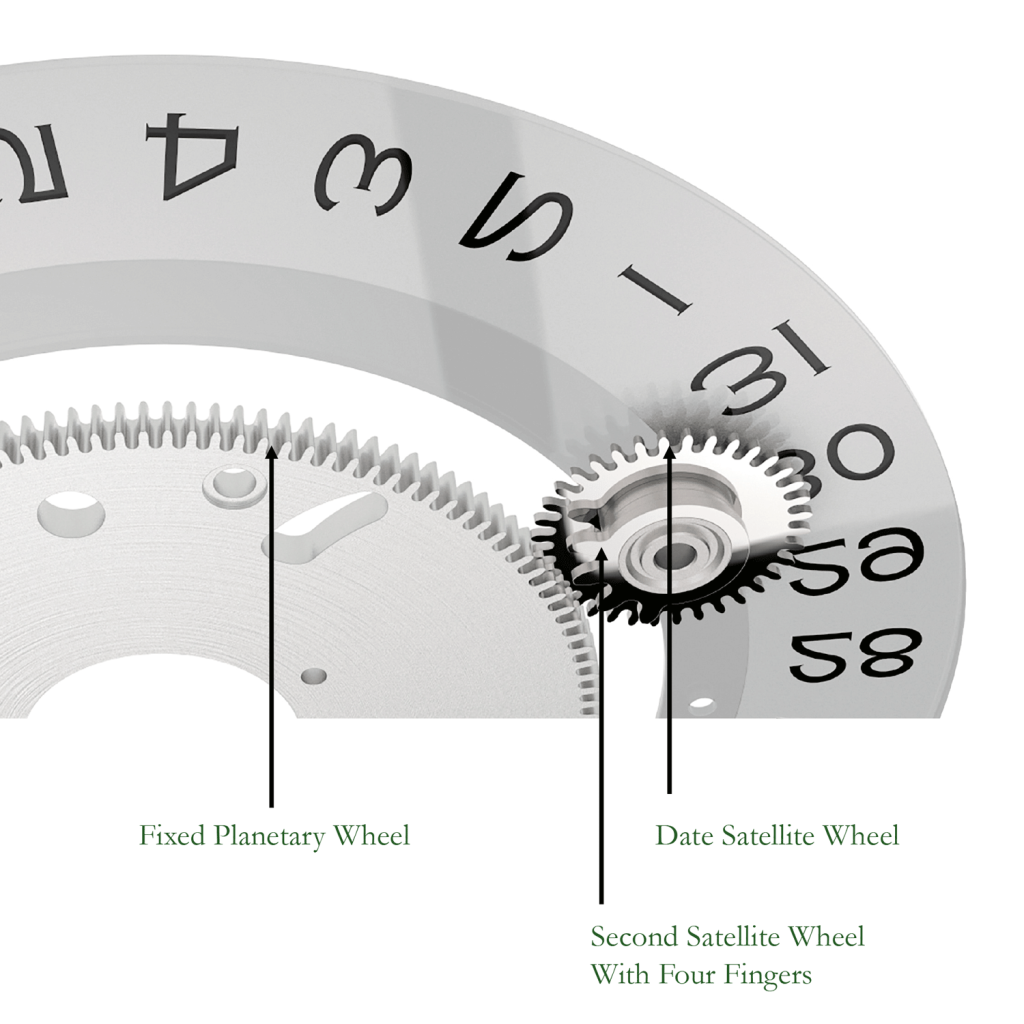
Labeled diagram of the Saros System
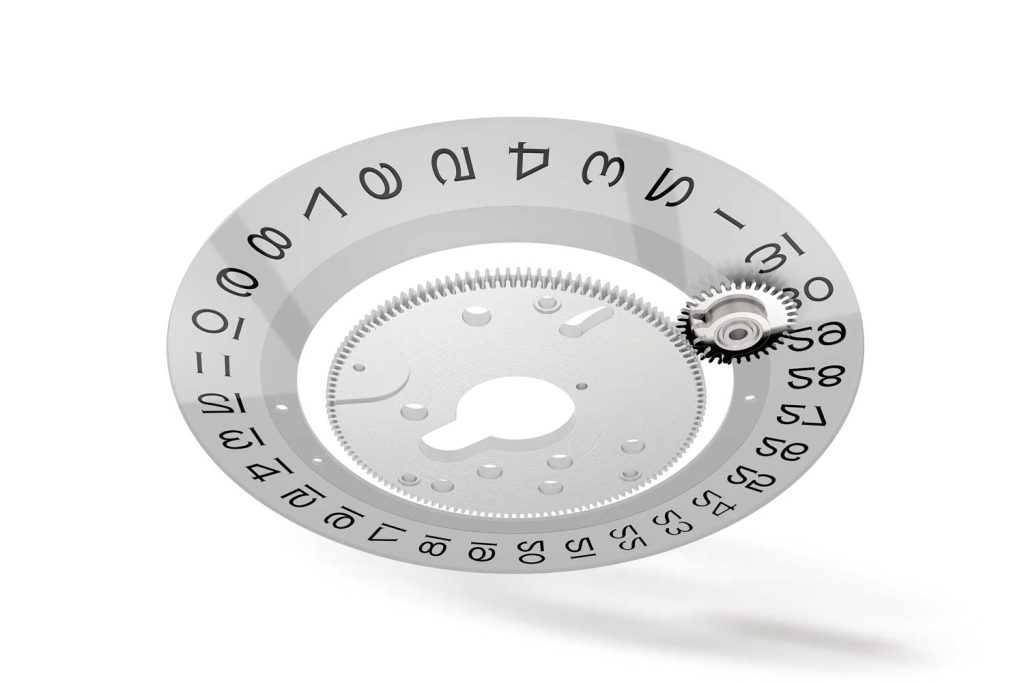
Saros is made up of three parts: the main satellite wheel for the date, the planetary wheel for the months and a second satellite wheel for the months with 30 days.
At the stroke of midnight on the 30th day of each of these months, this finger flicks the date disc to change over by two days, which to the eye appears as if the 30th of these months is transitioning directly to the 1st of the next month. Because the entire Saros system is based on planetary gears and discs, it can move backwards and forwards instantaneously.
As with all Rolex movements, despite its complexity, the calibre 9001 is built to offer the best performance in terms of accuracy, reliability and shock resistance. Accordingly, it uses a free-sprung balance wheel equipped with gold Microstella nuts. The balance wheel is fitted to a blue Parachrom hairspring, made from niobium, zirconium and oxygen, that is not affected by magnetism and that is 10 times more shock resistant than a traditional metal balance spring.
The balance is mounted on a staff that is held in place by jewels fitted with Rolex Parashock anti-shock devices that are up to 50 percent more shock resistant than traditional devices. The balance is held on a full traversing balance bridge which offers greater stability than a balance cock. The balance bridge features a special screw to raise or lower the balance for perfect engagement with the escapement.
The rotor is mounted on ceramic ball bearing for ultra-efficient winding, and the movement beats at 4Hz or 28,800vph.
Like all Rolex’s movements, the movements of the Sky-Dweller are first sent to the Contrôle Officiel Suisse des Chronomètres (COSC) for certification as chronometers. Rolex is the only one of three watch brands that undergoes a double certification process. Movements are sent to COSC facilities in Biel and Saint-Imier. They are tested for a total of 15 days, in five different positions with three temperature variations and must stay within a maximum deviation of −4/+6 seconds a day. Once the movements pass the test, they are sent back to Rolex with their certifications. The watches are cased and then these completed watches are tested again to Rolex’s standards of −2/+2 seconds per day. Since 2015, 100 percent of Rolex watches are tested in this way.
So there you have it — the Sky-Dweller, which is joined this year by versions fitted with Rolex’s epic Oysterflex bracelet, is a watch designed as the ultimate companion piece for the global traveller. But by making their watch so fun, easy to use, waterproof, it is actually a watch that is relevant to everyone. It is a complicated watch but one that is user-friendly, reliable and, let’s not forget, effortlessly good-looking. It is, in other words, a Rolex.










